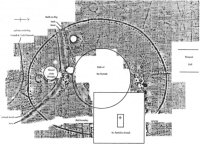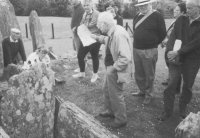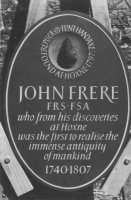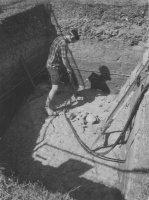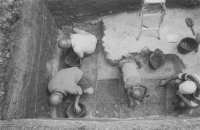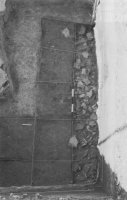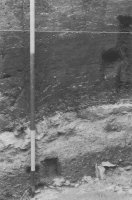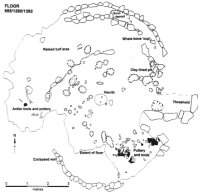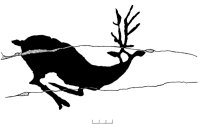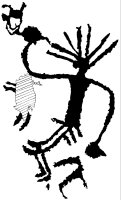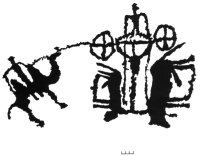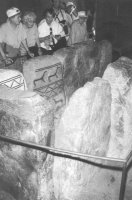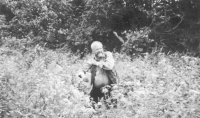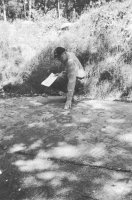|
|
|
|
Astonishing
New Monument at Tara
|
|
BUCKINGHAMSHIRE CLAIMS ITS ARCHAEOLOGY BACK!
Mike Farley
|
|
Martyn Barber |
|
CLEARING UP THE 'CLAY BISON' REFERENCE
Paul G. Bahn
|
|
|
|
|
|
|
HURRY! HURRY! Tickets are selling fast for the Millennium Picnic on 19th August 2000 - the more the merrier, but there will be a limit. The response has already been good enough to confirm the event and, even as I write, the brass band is practising, the theatre company are choosing their cast and the music hall singers are tuning up. Don't miss out on the event of the year (sorry, millennium), the more of you who want to come the more entertainment there will be. Advance bookings (£5 per head deposit except for under 4s) would be very helpful in planning the event so BOOK NOW via Tessa Machling. If you can't find your yellow form (with last issue of PAST) here is a reminder: The event is at the Larmer Tree Gardens, Tollard Royal, Wiltshire from 12.00 noon to 7.00 pm. It includes a buffet lunch, cream tea and lots of entertainments. Come in (Victorian) period costume if you possibly can. Prices are: £25 per head, £10 ages 4-14, under 4s free. Family concessions available, please contact Tessa. Let us know if you plan to come by train as we hope to provide a coach service. Accommodation details for the local area will be available in the New Year. Genuine offers of help on the day would be much appreciated. Julie Gardiner
|
|
SOCIETY
T-SHIRTS AND SWEATSHIRTS NOW AVAILABLE
|
|
|
|
| One of Britain's leading prehistorians, Jack Scott will be remembered by many who visited and worked in southern Scotland. He spent much of his working life in the Art Gallery and Museum in Glasgow, where he became Keeper of Archaeology, Ethnography and History. He helped many young students who came to see the collections and who benefited from his wise advice. His knowledge of the collections and of Scottish prehistory was vast. He excavated at a number of megalithic monuments, and members of the Society were privileged to hear his explanations at Cairnholy in south-west Scotland only last year (see PAST 30). | |
|
He was President of the Glasgow Archaeological Society, and one of the major figures in Scottish archaeology for many years. His interests were wide, and among them were arms and armour. He published widely and well. This writer remembers with real affection his visits to the Museum to look at bronze age material, to talk with Jack and to have splendid lunches with him and his dear wife Margaret, also an archaeologist who worked with Jack on many of his digs. Jack Scott died in early summer this year aged 86. His papers have been left to the RCAHMS where they will provide much opportunity for research. John Coles
|
|
| Due to limited time, it was not possible to excavate the whole of the trench area and work was concentrated on a strip against the section. A densely packed surface was revealed containing mint condition flint flakes and a handaxe amongst frost-fractured flint nodules and pieces (Fig. 3). All objects >=2cm were planned and recorded in detail, and all spoil was retained for sieving. Molluscs were shown to be present in a pale chalk pellet gravel between the grey soil and the breccia (a layer not found in the adjacent 1975 trench), and also in the loams overlying the breccia (Fig. 4). None of these deposits has previously been sampled for biological remains and it is hoped that study of the samples taken will produce evidence which clarifies the sequence of environmental and climatic conditions represented at the site, and helps explain the formation of the breccia. The small size of the trench meant that no conclusions could be drawn about the local topography and extent of the breccia and the underlying sedimentary units and archaeological evidence. Although these data would be of great interest, the difficulties of chasing deposits at this depth (2.5m) suggest that they will remain a mystery for a while yet. |
| As a final comment, it is worth noting that by all predictive modelling of the locations of palaeolithic sites in Pleistocene sediments, the site at Red Barns should not exist, and on top of that the location is mapped as chalk bedrock in the most recent British Geological Survey edition of the Fareham sheet (1998). This should serve as a warning against neglecting field evaluation for palaeolithic evidence even in apparently unpromising locations, and one can only pay grateful tribute to the voluntary work of Chris Draper which led to the discovery and recognition of the site, while trying not to lose sleep over sites which have not been similarly well served. |
|
References Acknowledgements Francis Wenban-Smith
|
|
THE
PETROGLYPHS OF THE DZHUNGARIAN ALATAU MOUNTAINS IN SOUTHEAST KAZAKSTAN
|
|
|
The 1999 season of the Joint Anglo-Kazak investigations of the petroglyphs
in the Republic of Kazakstan was successfully concluded this past summer.
Research was conducted in collaboration between the Department of Archaeology,
University of Southampton and with Dr. Zainolla Samashev of the A.Kh.
Margulan Institute of Archaeology, Almaty, Kazakstan. Our expedition
was supported with the assistance of the Prehistoric Society's Research
Fund and the University of Southampton. |
|
|
|
|
| The second site investigated was found in the Bayan Zhurek hills near the town of Kopal (northeast of Taldy-Kurgan). The large body of petroglyphs has not been fully published yet but Bayan Zhurek has come to the attention of Kazak scholars with the discovery of two rare depictions of dancing shamans (Samashev 1998: figs 1, 2). One image was carved on a stone atop the highest hill, which commands a breathtaking view of the snow capped Dzhungarian peaks and the plains of the steppe. As an exclusive to PAST readers, our newly corrected version of this image is shown in fig. 2. There are many scenes from the bronze age including "solar symbols" (large images of circles connected to single lines), cattle, human figures and one chariot. There were Sako-Scvthian scenes of wild boar and goats and many scenes from the early Turkic period including images of horse-mounted warriors carrying flagged poles. Several new petroglyphs were also discovered this year including a couple of scenes associated with concentrations of dots, some scenes of human figures and a lichen-obscured scene with a meandering line close to the dancing shaman's stone. |
|
Animals such as horses, goats, bulls, camels and deer held many important aspects for ancient societies and they were commonly depicted in the rock art of Central Asia. By the close examination of the petroglyph sites of Kazakstan we can begin to explore the diversity of practices involving these animals and other important symbols. The images found at Eshkiol'mes and Bayan Zhurek are excellent examples of this diversity as they represent idiosyncratic practices conducted by members of an ancient community. Eshkiol'mes was full of scenes of chariots while out of the hundreds of images found at Bayan Zhurek there was only one chariot and it was directly associated with a camel (fig. 3). Eshkiol'mes also had a concentration of Sako-Scythian deer localised on one hillside while Bayan Zhurek had none. The complexity of these and other relationships will be further explored as part of ongoing doctoral research. The future will also see a joint Anglo-Kazak paper that will examine in more depth several petroglyph sites, including Eshkiol'mes and Bayan Zhurek, for an English speaking audience.
|
|
References Kenneth Lymer
|
|
IN
SCANIA WITH THE SOCIETY
|
| The 1999 study tour to Scania in southern Sweden was organised
in conjunction with Andante Travel and was led by Professor Lars Larsson
and Dr. Debbie Olausson from the University of Lund, with Professor John
Coles guiding the rock art sites. The Society's president, Professor Paul
Mellars, joined us for the final weekend. The tour was supported by 32
members of which I was the fortunate student to have been given a free
place. An excellent field guide with copious maps and drawings was prepared by our Swedish lecturers. The first evening began with a visit to the Historical Museum of the University of Lund with a sherry reception and some background lectures to the prehistory of Scania. This gave us an opportunity to learn much from this teaching museum of the chronology of the area of Sweden we were to visit. The eight days contained an excellent mix of predominantly familiar prehistoric site types, ranging from passage graves and bronze age mounds to rock art and bogs, and the less familiar Viking ship-settings, runic stones, apsidal ended churches and castles. |
|
We visited several
different neolithic sites. From the top of the Gillhög passage tomb
we could see Denmark across the Öresund. The tomb is dated to the early
middle neolithic period, but most of the finds are later. It had multi-use
with later graves inserted into the mound. A curious inclusion is the
packing of Funnel Beaker pottery at the entrance. Although there was
no art, the pottery designs reflect the carving from the Brittany passage
tombs. Only inhumation was found here with bone being deposited in designated
areas within the chamber. Lars went ahead to light candles in the tomb
and we had to crawl through a long, low passage which opened into a
single chamber. The roof had an enormous capstone which could be seen
from the top of the tomb. In neolithic times it must have been a remarkable
site with the sea much closer and stretches of water around it. |
| We had the added bonus of visiting the mesolithic cemetery at Skateholm which Lars excavated in the 1980s when over 100 skeletons were found, together with dog burials and bones of cattle, goat and pig. One of the skeletons with its grave goods is on display in Lund museum. The Ageröd Bog site shows continuity from the late mesolithic to the early neolithic and is part of a larger bog complex covering 12 sqkm. Thousands of worked flints have been found, together with worked bone and antler. It was here that John Coles picked up a handle core in the ploughed field we were walking around. |
| Probably
the most thrilling experience was to see the rock art at Simris, Järrestad
and Frännarp. Simris is a quartzite outcrop which runs parallel to the
sea for about 10km, where there are carvings of animals, boats and battle-axes.
Further inland at Järrestad is the largest rock carving site in Scania,
also on quartzite. It must be viewed as part of a late Bronze Age landscape,
with the Järrestad barrow being the focal point with the sea behind. The
quartzite surface is ideal for carving and the natural cracks in the rocks
have been used as frames for many of the carvings. There are spirals and
geometric designs, feet in pairs, sickles, humans on horses with loose
reins and "The Dancer" as the main focus. At Frännarp the art is quite
different and shows horses and carts carved on a granular stone. Draught
animals are 'folded out' to be viewed from above in 2 dimensions. In Sweden there is a superb attitude to hands-on teaching for children, and we visited two experimental sites: one where children could practise dyeing cloth with vegetable dyes in a Viking fort at Trelleborg, and another where they could sleep overnight on reindeer skins in a vast longhouse at the experimental Viking village at Hög. |
|
This study tour reflected
both the continuity of early prehistoric sites and the wider landscapes
of the bronze age. It introduced us to monuments we had no experience
of, such as the ship-settings and the runic stones. It made us draw
parallels with Britain and Ireland and prompted much debate about interpretation.
Our guides were excellent and the tour was superbly organised. Paula Gardiner
|
 |
The Prehistoric Society Home Page |
